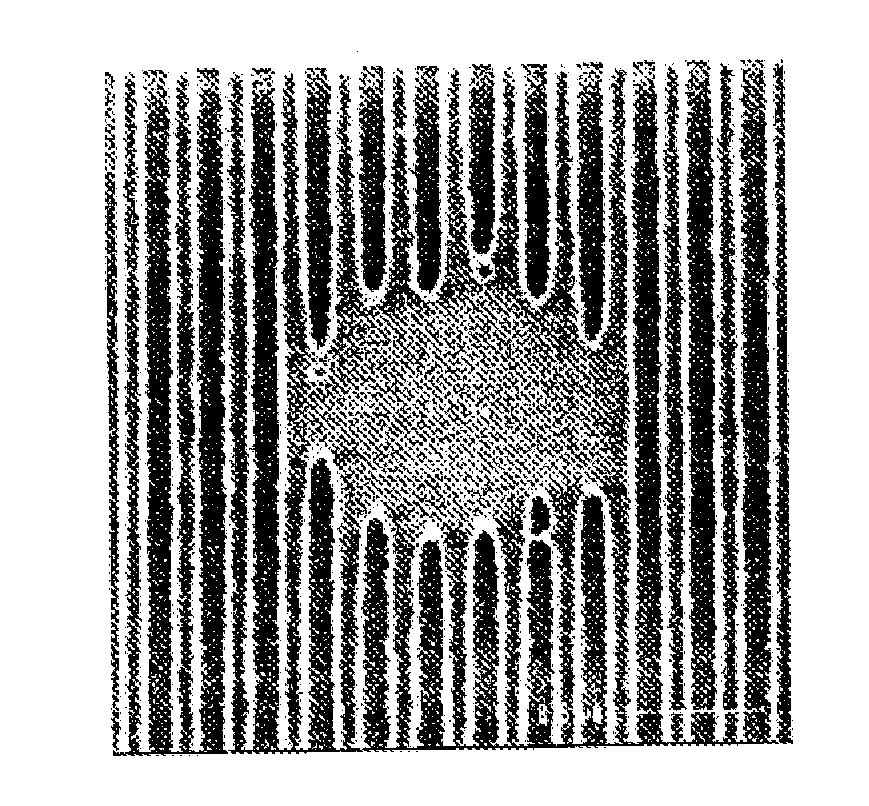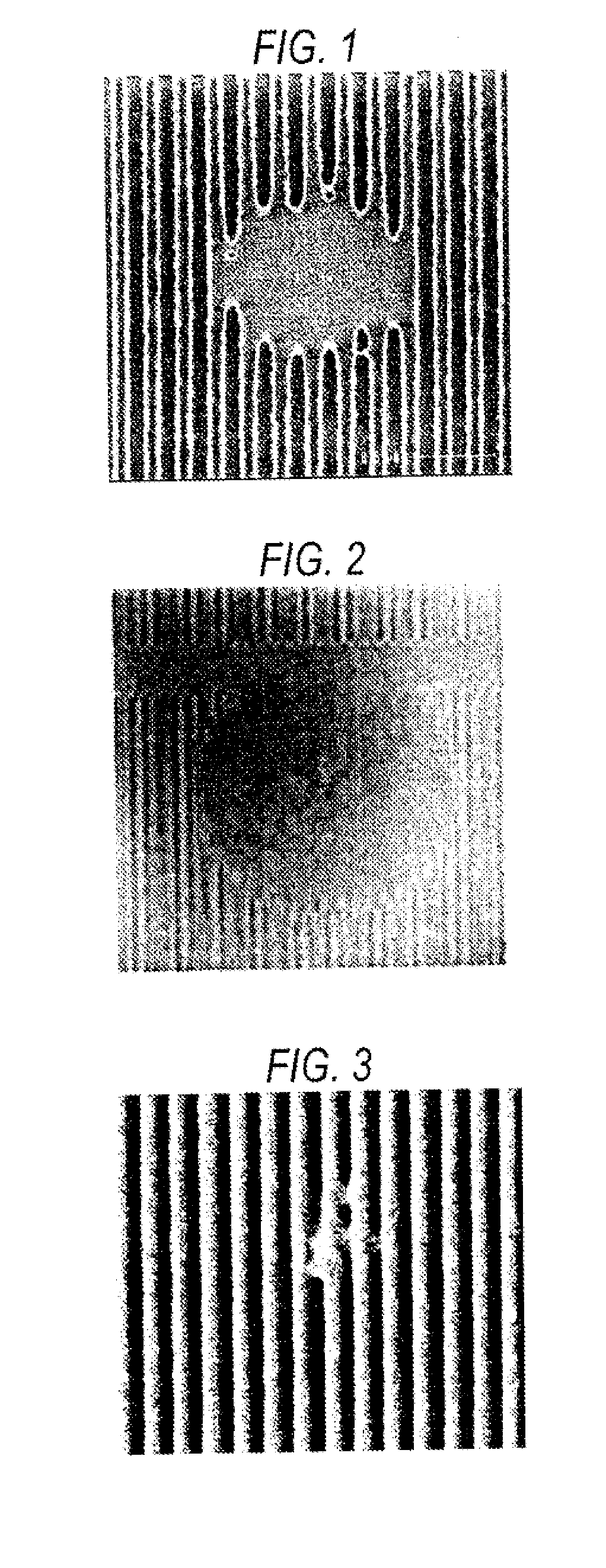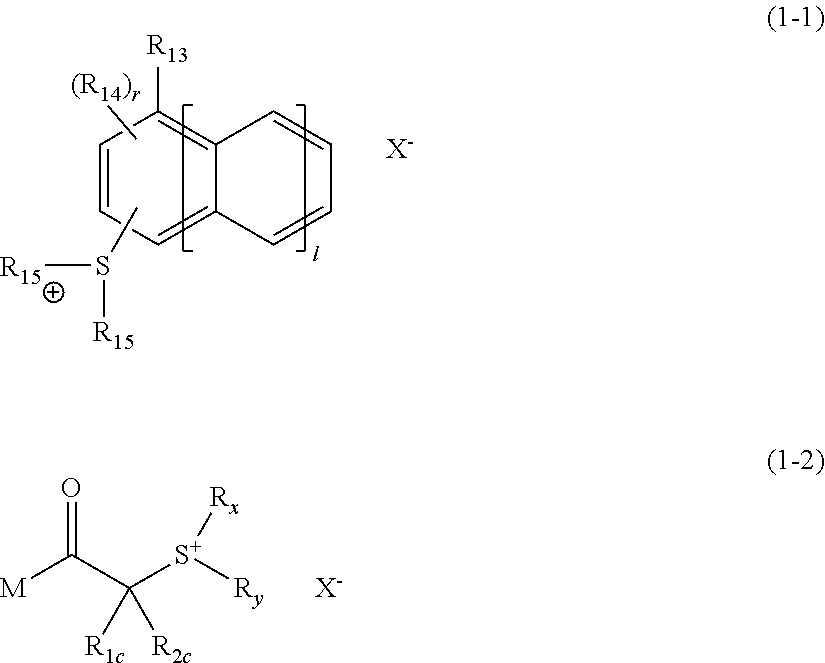Actinic ray-sensitive or radiation-sensitive resin composition and pattern forming method using the same
a technology of radiation-sensitive resin and resin composition, which is applied in the direction of photosensitive materials, instruments, photomechanical equipment, etc., can solve the problems of adversely affecting the bleedout of immersion liquid from the resist layer, the performance of the roughening of the pattern side wall in line width roughness is not satisfied, and the resist layer deterioration, so as to reduce the development defect and good performance
- Summary
- Abstract
- Description
- Claims
- Application Information
AI Technical Summary
Benefits of technology
Problems solved by technology
Method used
Image
Examples
synthesis example 1
Monomer Synthesis Example 1
Synthesis of Compound (4)
[0702]The following Compound (1) was synthesized by the method described in International Publication No. WO07 / 037,213, pamphlet.
[0703]To 35.00 g of Compound (1), 150.00 g of water was added, and 27.30 g of NaOH was further added. The mixture was stirred for 9 hours under heating and refluxing conditions, made acidic by adding hydrochloric acid and then extracted with ethyl acetate. The organic layers were combined and concentrated to obtain 36.90 g of Compound (2) (yield: 93%).
[0704]1H-NMR (400 MHz in (CD3)2CO): δ (ppm)=1.56-1.59 (1H), 1.68-1.72 (1H), 2.13-2.15 (1H), 2.13-2.47 (2H), 3.49-3.51 (1H), 3.68 (1H), 4.45-4.46 (1H).
[0705]To 20.00 g of Compound (2), 200 ml of CHCl3 was added, and 50.90 g of 1,1,1,3,3,3-hexafluoroisopropyl alcohol and 30.00 g of 4-dimethylaminopyridine were further added. The obtained mixture was stirred and to the resulting solution, 22.00 g of 1-ethyl-3-(3-dimethylaminopropyl)carbodiimide hydrochloride wa...
synthesis example 2
Synthesis of Resin (C-8)
[0709]In a nitrogen atmosphere, 6.4 g of propylene glycol monomethyl ether acetate (PGMEA) was charged into a three-neck flask and heated to 80° C. Thereto, a solution prepared by dissolving 17.5 g of Compound (1), 4.0 g of Compound (2) and polymerization initiator V-601 (produced by Wako Pure Chemical Industries, Ltd.) in a ratio of 5.0 mol % based on the monomers, in 58.0 g of PGMEA was added dropwise over 4 hours. After the completion of dropwise addition, the reaction was further allowed to proceed at 80° C. for 4 hours. The resulting reaction solution was left standing to cool and then added dropwise to a mixed solution of 1,300 g of methanol / 150 g of distilled water over 20 minutes, and the powder precipitated was collected by filtration and dried, as a result, 15.2 g of Resin (C-8) was obtained.
[0710]The weight average molecular weight of Resin (C-8) was 8,000 in terms of standard polystyrene and the polydispersity (Mw / Mn) was 1.3.
synthesis example 3
Synthesis of Resin (C-94)
[0711]In a nitrogen atmosphere, 10.1 g of propylene glycol monomethyl ether acetate (PGMEA) was charged into a three-neck flask and heated to 80° C. Thereto, a solution prepared by dissolving 36.3 g of Compound (3) and polymerization initiator V-601 (produced by Wako Pure Chemical Industries, Ltd.) in a ratio of 2.5 mol % based on the monomer, in 96.8 g of PGMEA was added dropwise over 4 hours. After the completion of dropwise addition, the reaction was further allowed to proceed at 80° C. for 4 hours. The resulting reaction solution was left standing to cool and then added dropwise to a mixed solution of 1,300 g of methanol / 150 g of distilled water over 20 minutes, and the powder precipitated was collected by filtration and dried, as a result, 25.1 g of Polymer (C-94) was obtained.
[0712]The weight average molecular weight of Polymer (C-94) was 13,000 in terms of standard polystyrene and the polydispersity (Mw / Mn) was 1.4.
[0713]Other resins (C) shown in Tabl...
PUM
 Login to View More
Login to View More Abstract
Description
Claims
Application Information
 Login to View More
Login to View More - R&D
- Intellectual Property
- Life Sciences
- Materials
- Tech Scout
- Unparalleled Data Quality
- Higher Quality Content
- 60% Fewer Hallucinations
Browse by: Latest US Patents, China's latest patents, Technical Efficacy Thesaurus, Application Domain, Technology Topic, Popular Technical Reports.
© 2025 PatSnap. All rights reserved.Legal|Privacy policy|Modern Slavery Act Transparency Statement|Sitemap|About US| Contact US: help@patsnap.com



